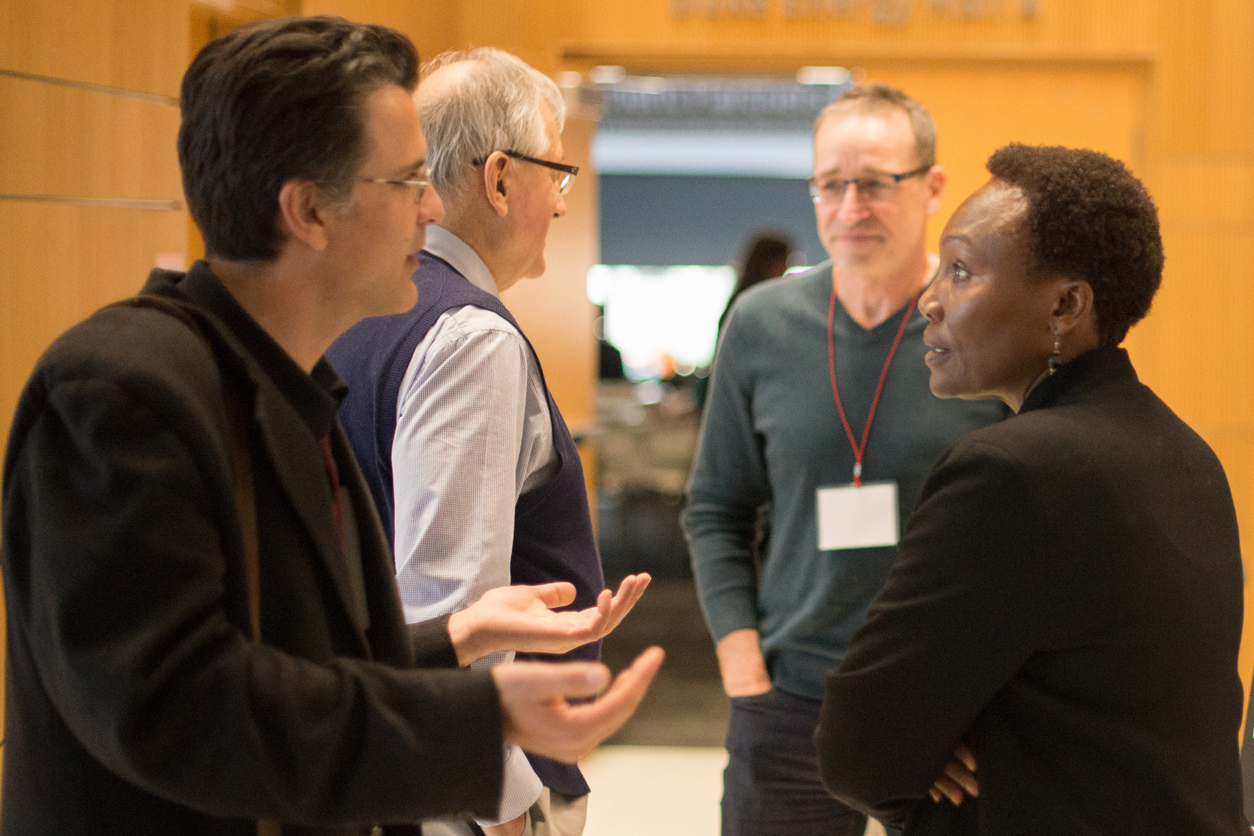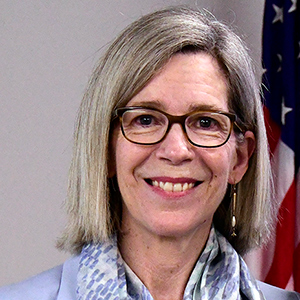 Rick Woychik, Ph.D., directs NIEHS and the National Toxicology Program. (Image courtesy of NIEHS)
Rick Woychik, Ph.D., directs NIEHS and the National Toxicology Program. (Image courtesy of NIEHS)This month marks the first anniversary of the Director’s Corner, which I launched to share innovative ideas and promote collaboration across the environmental health sciences community. I recently spoke with NIEHS grantee Cathrine Hoyo, Ph.D., from North Carolina State University (NC State), who conducts research that is both innovative and collaborative, and I think that our conversation provides the perfect segue into the new year.
Hoyo aims to shed light on how early environmental exposures affect humans later in life. She designs rigorous epidemiological studies involving diverse populations and toxic agents of great public health significance, and her efforts are informed by epigenetic analysis. Epigenetics refers to chemical modifications on DNA or the proteins associated with DNA that affect how genes are turned on and off. Hoyo seeks to boost knowledge about conditions such as obesity and liver dysfunction by identifying epigenetic changes that are caused by developmental exposure to cadmium, per- and polyfluoroalkyl substances (PFAS), and other contaminants.
 Hoyo is a prolific researcher who has published almost 160 peer-reviewed scientific papers. (Photo courtesy of Cathrine Hoyo)
Hoyo is a prolific researcher who has published almost 160 peer-reviewed scientific papers. (Photo courtesy of Cathrine Hoyo)Through that research, she advances a framework known as developmental origins of health and disease (DOHaD) and uncovers how African Americans may be disproportionately affected by certain exposures. A native of Zimbabwe, Hoyo is a Distinguished Professor at NC State, where she leads the Epigenetics, Cancer, and the Environment Laboratory. She also is co-director of the Integrative Health Science Facility Core in the university’s NIEHS-funded Center for Human Health and the Environment (CHHE).
Liver diseases, heavy metals, and PFAS
Rick Woychik: You are spearheading the Southern Liver Health Cohort, a major new project funded by NIEHS and the National Cancer Institute. The aim is to increase understanding about which environmental contaminants may be linked to liver cancer and its precursors, including fibrosis, in an ethnically diverse population of 16,000 men and women. Can you share with our readers the impetus for this initiative, and what specifically do you hope to learn?
Cathrine Hoyo: Sure. We are part of five teams that are developing new cohorts that will help to advance basic research across the country. Our group is looking at both heavy metals and PFAS, and we will collect blood, urine, and tissue samples from a diverse adult population and follow those individuals over time. The goal is to see who develops nonalcoholic fatty liver disease, how that may progress to fibrosis, and how that in turn may lead to liver cancer.
One reason I wanted to be part of this project is because of my previous research involving the NIEHS-funded Newborn Epigenetics Study Cohort(https://tools.niehs.nih.gov/cohorts//main/detail/ids/c178). As part of that ongoing effort, we studied a group of women in Durham, North Carolina, to learn how environmental stress — cadmium exposure — around the time of pregnancy influenced health outcomes in their children.
We found that 10% of African American children had nonalcoholic fatty liver disease by age 10 — an alarming percentage, and one that was significantly higher than what we saw in other children. Our group would not have discovered that if the cohort was not ethnically diverse, and I think that such diversity will be a major benefit to the Southern Liver initiative, too.
 Hoyo delivered a 2013 NIEHS Keystone Science Lecture titled “Testing the Developmental Origins of Adult Diseases Hypothesis: The Durham Newborn Epigenetics Study.” (Photo courtesy of Steve McCaw / NIEHS)
Hoyo delivered a 2013 NIEHS Keystone Science Lecture titled “Testing the Developmental Origins of Adult Diseases Hypothesis: The Durham Newborn Epigenetics Study.” (Photo courtesy of Steve McCaw / NIEHS)When we look at the incidence of liver cancer, we see that the steepest increases in the last 15-20 years are in the southeastern and southwestern United States. We want to learn why that is so, and I think that through further study of the cohort of children and now the Southern Liver project, we are positioned to do exactly that.
Learning how maternal exposures affect children
RW: What inspired you to study DOHaD and to merge insights from the field of epigenetics?
CH: Back in the early 2000s, I was at Duke University, in the lab of Randy Jirtle. He had followed up with your experiments involving the agouti gene and published a seminal paper demonstrating that certain nutritional exposures experienced on the maternal side can lead to potentially harmful epigenetic modifications that affect offspring. I was — and still am — interested in how the environment can affect gene expression and ultimately influence metabolic dysfunction, including obesity, so his work has been a major source of intellectual inspiration.
In my early studies, I focused on an imprinted gene called insulin-like growth factor 2 [IGF2], which regulates the body’s growth hormone. Expression of an imprinted gene is determined by the parent who contributed it, and such expression is based on epigenetic modifications in the germline, meaning sperm and egg cells. Loss of imprinting in IGF2 is linked to conditions such as diabetes and cardiovascular disease, and it can predispose some individuals to obesity.
Identifying key epigenetic events that drive disease
RW: What came after that research?
CH: I wanted to identify a broad set of imprinted genes that would help us better assess the mechanisms through which exposures perturb gene expression and affect obesity. For epidemiologists, having a repertoire of these genes would be a gold mine because we know when epigenetic marks are established in them. We would be able to determine when — and how — an exposure causes loss of imprinting.
Such a robust set of genes would allow us to evaluate the effects of exposures that occur very early in life, even when the woman does not yet know she is pregnant. That knowledge could aid disease prevention efforts and lead to therapeutic advances.
So, that started me along the path of first looking at known imprinted regions, and I published a related paper in 2012 with my colleague David Skaar. Around that time, I was studying imprinted genes in relation to cadmium because I found a cluster of individuals in Durham County who had been exposed to the metal. I developed cohort studies examining exposures in very early pregnancy, trying to analyze resulting epigenetic changes.
However, that proved inefficient, so we did whole genome analyses to see which imprinted regions would truly shed light on the early-life epigenetic consequences of exposure to cadmium and other heavy metals. We discovered that some regions were more useful for this kind of research than others, and we published our findings in the journal Environmental Health Perspectives.
Eventually, I collaborated with a bioinformatician from [CHHE] to take a deeper dive into these imprinted genes. We have discovered more than 300 regions that we think hold promise in terms of helping scientists understand the epigenetic effects of exposures, and our findings will be published soon.
Also, we are working with the biotech company Illumina to develop a platform — based on these imprinted regions — that allows other researchers to study more exposures and diseases through an epigenetic lens. I am quite excited about what the future holds.
 CHHE member Keith Linder, D.V.M., Ph.D., left, chatted with Hoyo during the center’s first annual symposium in 2017. In the background, from left, are CHHE members Jirtle and Scott Belcher, Ph.D. (Photo courtesy of Ahmed Mohammed)
CHHE member Keith Linder, D.V.M., Ph.D., left, chatted with Hoyo during the center’s first annual symposium in 2017. In the background, from left, are CHHE members Jirtle and Scott Belcher, Ph.D. (Photo courtesy of Ahmed Mohammed)State-of-the-art equipment, research support
RW: That sounds fascinating, and I think your efforts will enable scientific breakthroughs in the coming years. You mentioned CHHE. Can you talk about your involvement with the center?
CH: Yes, absolutely. This NIEHS-funded center has provided me and other researchers with more opportunities for partnership, and for that I am grateful. The center has a full-time bioinformatician who can work in a variety of models, whether involving zebrafish, mice, or human epidemiological studies.
There is an interdisciplinary element that also is unique, in my view. We have more than 70 investigators from across a variety of departments at NC State, and researchers often collaborate with scientists from nearby universities.
Also, the center offers state-of-the-art equipment and funding that enable me to conduct studies that I otherwise would be unable to even think about [laughs].
For example, the Southern Liver Health Cohort started as a $50,000 pilot project. Half of that amount came from [CHHE], and the other half came from the UNC [University of North Carolina at Chapel Hill] Center for Environmental Health and Susceptibility, which also is funded by NIEHS. It has been exciting to watch the study blossom into something much more comprehensive.
Citations:
House JS, Hall J, Park SS, Planchart A, Money E, Maguire RL, Huang Z, Mattingly CJ, Skaar D, Tzeng JY, Darrah TH, Vengosh A, Murphy SK, Jirtle RL, Hoyo C. 2019. Cadmium exposure and MEG3 methylation differences between Whites and African Americans in the NEST Cohort. Environ Epigenet 5(3):dvz014.
Bultman SJ, Michaud EJ, Woychik RP. 1992. Molecular characterization of the mouse agouti locus. Cell 71(7):1195–204.
Michaud EJ, van Vugt MJ, Bultman SJ, Sweet HO, Davisson MT, Woychik RP. 1994. Differential expression of a new dominant agouti allele (Aiapy) is correlated with methylation state and is influenced by parental lineage. Genes Dev 8(12):1463–72.
Waterland RA, Jirtle RL. 2003. Transposable elements: targets for early nutritional effects on epigenetic gene regulation. Mol Cell Biol 23(15):5293–300.
Do EK, Zucker NL, Huang ZY, Schechter JC, Kollins SH, Maguire RL, Murphy SK, Hoyo C, Fuemmeler BF. 2019. Associations between imprinted gene differentially methylated regions, appetitive traits and body mass index in children. Pediatr Obes 14(2):e12454.
Skaar DA, Li Y, Bernal AJ, Hoyo C, Murphy SK, Jirtle RL. 2012. The human imprintome: regulatory mechanisms, methods of ascertainment, and roles in disease susceptibility. ILAR J 53(3-4):341–58.
King KE, Darrah TH, Money E, Meentemeyer R, Maguire RL, Nye MD, Michener L, Murtha AP, Jirtle R, Murphy SK, Mendez MA, Robarge W, Vengosh A, Hoyo C. 2015. Geographic clustering of elevated blood heavy metal levels in pregnant women. BMC Public Health 15:1035.
Cowley M, Skaar DA, Jima DD, Maguire RL, Hudson KM, Park SS, Sorrow P, Hoyo C. 2018. Effects of cadmium exposure on DNA methylation at imprinting control regions and genome-wide in mothers and newborn children. Environ Health Perspect 126(3):037003.
(Rick Woychik, Ph.D., directs NIEHS and the National Toxicology Program.)









